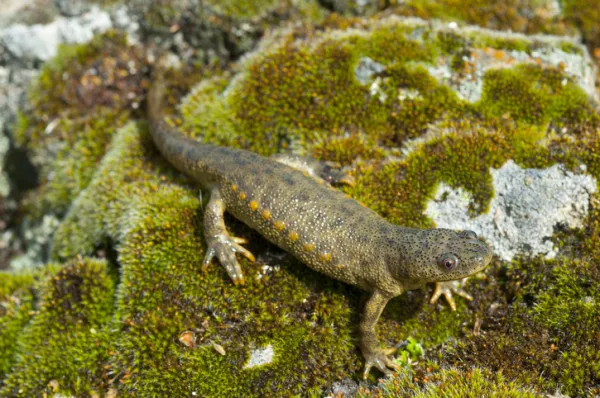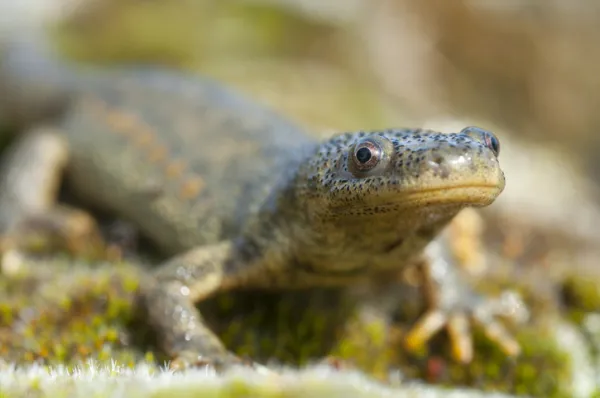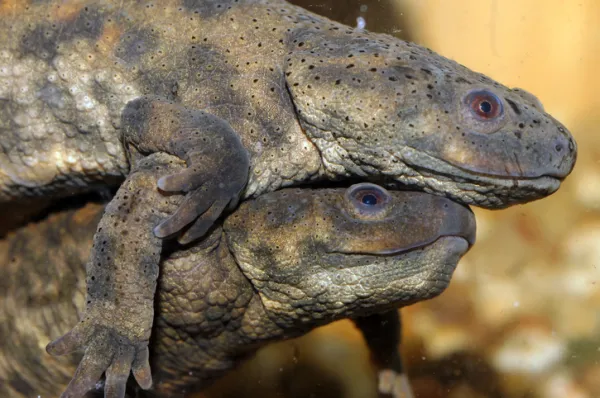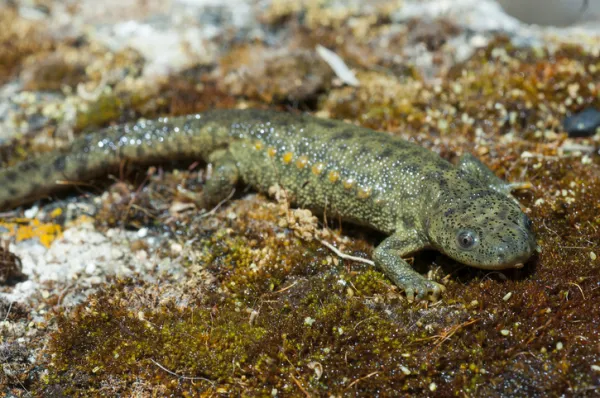Amphibians are incredible creatures. They were the first vertebrates to conquer land, and they exhibit unique features that make them truly remarkable. Among them is a species found primarily on the Iberian Peninsula: the Gallipato (Pleurodeles waltl).
If you've never heard of this animal, this article will introduce you to the Gallipato—Europe’s largest salamander—and cover its biology, habitat, reproduction, and one of the most fascinating defense mechanisms in the amphibian world.

The Gallipato (Pleurodeles waltl) is a species of newt and the largest urodela amphibian in Europe. It belongs to the family Salamandridae, which includes true salamanders and newts. Here's a breakdown of its most notable traits:
Size: Males can reach up to 31 cm in length, while females grow to about 29 cm. In captivity, they typically measure between 15 and 25 cm.
Tail Retention: As a urodela, the Gallipato retains its tail after metamorphosis.
Adapted Tail: The tail makes up 46% to 55% of its total body length and is laterally compressed for swimming.
Limbs: The front limbs have four fingers, while the hind limbs have five toes.
Head Shape: The head is broad and flattened, with small upward-facing eyes and a rounded pupil. It also has a vocal or throat fold.
Skin Texture: During aquatic stages, the skin is smooth and slippery. In terrestrial stages, it becomes rough and granular.
Coloration: Their coloration varies from dark brown, grey, to olive, with scattered black spots. They usually have 7–10 yellow or orange spots running down each side. The belly is always lighter than the dorsal surface.
Tubercles: Small glandular lumps are arranged in rows along the sides—these play a role in its unique defense mechanism.

The Gallipato is endemic to the Iberian Peninsula and parts of North Africa, specifically northern and western Morocco. Its habitat spans:
Spain: Central and southern regions, avoiding the northeast and Cantabrian areas.
Morocco: Northern and western regions.
This amphibian alternates between aquatic and terrestrial phases throughout the year. Though it can survive on land, it prefers areas near permanent or semi-permanent water bodies such as:
Wells
Cisterns
Abandoned pools
Reservoirs
Being nocturnal and elusive, Gallipatos hide during the day and become active at night, feeding on aquatic invertebrates, small vertebrates (like tadpoles and small fish), and even carrion.

Gallipatos primarily breathe through lungs as adults but also perform cutaneous respiration (through their skin), especially in aquatic environments. During warm weather, they often rise to the water surface for air.
For more information on animal respiration, see:
“Animals That Breathe Through Their Skin”
“105+ Animals That Breathe with Lungs”
Gallipato reproduction is tightly linked to seasonal and aquatic conditions:
Breeding Season: Begins in early spring, as rainfall increases and temperatures rise.
Mating Behavior: Males develop special calluses on their arms and may grasp females in amplexus, which can last hours to days. Alternatively, males may wave their tails in front of females as a courtship display.
Fertilization: The male deposits a spermatophore (sperm capsule) on the substrate, which the female picks up with her cloaca. Each male may deposit up to 6–7 spermatophores.
Egg Laying: Females lay between 300 to 1,300 eggs, either singly or in small clusters.
Larval Development: Larvae hatch and grow for about three months in aquatic conditions, reaching up to 10 cm before metamorphosis. They reach sexual maturity at about one year of age.

One of the most astonishing facts about the Gallipato is its defense system. Despite its docile appearance, the Gallipato is indeed venomous—though not to humans under normal circumstances.
Here’s how it works:
When threatened, it pushes the sharp tips of its ribs outward through specialized glands in the skin.
These glands release toxins, and the sharp ribs act like venomous needles.
If a predator bites the Gallipato, the sharp, toxic ribs pierce into the predator’s mouth, causing pain and deterring further attack.
This rib-spike mechanism is rare and extremely effective—a prime example of evolution’s ingenuity.

The Gallipato is more than just Europe's largest newt. It is a master of adaptation, with a flexible lifestyle, unique defense abilities, and a deep-rooted evolutionary legacy. Its presence reflects the biodiversity richness of the Iberian Peninsula and North Africa.
If you enjoyed this article, be sure to check out related topics such as:
“Classification and Characteristics of Vertebrate Animals”
“Types of Amphibians and Their Habitats”
Explore more in our Wild Animals category.
Bibliography
The Timon Herpetological Association. (2020). Gallipato / Ofegabous (Pleurodeles waltl). Retrieved from: https://www.timonassociation.org/species/pleurodeles-waltl/c
Alarcos , G. , Ortiz , M. E. , Fernandez , M. J. , & Avia , M. L. (2006). Predation of the gallipato (Pleurodeles waltl) by otters in Los Arribes del Duero, Salamanca. Bulletin of the Spanish Herpetological Association, 17(2), 85-87.
Salvador, A. (2002). Gallipatho–Pleurodeles waltl (Michahelles, 1830).
animal tags: gallipato
We created this article in conjunction with AI technology, then made sure it was fact-checked and edited by a Animals Top editor.